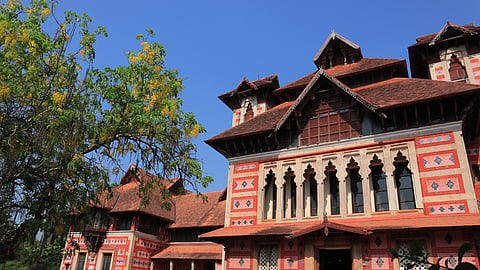
- Destinations
- Experiences
- Stay
- What's new
- Editor’s Picks
- Responsible Tourism
- CampaignsCampaigns
- Subscribe

Built in 1855, the Napier Museum houses an extensive collection of art and natural history exhibits. Designed by Robert Fellowes Chisholm, the museum was opened to the public in 1880 by Ayilyam Thirunal Maharaja of Travancore. This exquisite gem was named after Lord Napier, the governor-general of Madras province. Chisholm was a passionate advocate of native art, and as a result, the Napier Museum turned out to be a sensational testament to the fusion of traditional and contemporary architectural styles. Built on a sprawling 55-acre plot of land, this site also boasts one of India's oldest zoological gardens, dating back to 1857.
The museum's garden is a sight to behold, with various trees and flowers that will make your heart skip a beat, including the oldest rubber tree in Kerala, brought from Ceylon in 1876 and planted by Visakham Thirunal. It's like a living piece of history in the museum's backyard. As you traverse the verdant foliage, a striking red-and-white structure with a Gothic roof looms into sight. Yet, it must be noted that Chisholm would disapprove of labelling the top as Gothic, as he favoured the stacked roofs of the Kuthira Malika Palace for inspiration. The Maharajah himself expressed disappointment with the museum's deviation from the Gothic style.
Nevertheless, the architecture remains a delightful fusion of Indian, Chinese, Kerala, and Mughal architecture schools. Three grandiose halls connect lengthy corridors embellished with four towering structures, numerous gables, and exquisite ceiling panels. The woodwork is divine, and the coloured panes and artistically painted walls, both inside and outside, are a feast for the eyes. The Indo-Saracenic style also provides a natural air-conditioning system, making it a refreshing oasis on a scorching summer day.
However, the true treasure lies within the walls of this masterpiece. The museum showcases a remarkable collection of ancient artefacts and exquisite artwork embodying India's rich cultural heritage. From bronze idols to old coins, wood carvings to stone sculptures, and even a temple chariot, palanquin, and ivory carvings, this museum houses a vast collection of antique objects that will leave you in awe. The museum's ambience is reminiscent of a time machine but without the complexities of science. The museum also showcases Indian epics like the Mahabharata and Ramayana, depicted using Japanese shadow-play leather. It is a remarkable experience that will leave you with a newfound appreciation for India's rich cultural heritage.
The interiors are just as astonishing as the exteriors, with light streaming in from the stacked roof and illuminating a ceiling adorned with painted beams, ornamental carvings, balconies, and painted walls.
Napier Museum houses an impressive ancient 5,000-odd coin collection and a natural history museum where you can get up close and personal with skeletons of birds and animals and marvel at the taxidermy galleries. It is a cornucopia of preserved creatures, from elephants to butterflies, boasting specimens from around the globe.
In the Art section, you will find the piece de resistance -- an array of Ravi Verma's paintings, sculptures, artefacts, and exquisitely crafted ancient bronze idols. The museum's Ethnography section displays the locals' dresses, jewellery, and lifestyle. The recreated models of traditional homes are like peeking into a time capsule and getting a glimpse of the everyday lives of those who once lived in them. And for all the art aficionados out there, the Shri Chitra Art Gallery is an absolute must-see. The double walls with ventilation in the museum provide natural air-conditioning and preserve artefacts while keeping visitors comfortable. But the unsung heroes of the museum's faccedilade are its windows, which give ornamentation and light and play a crucial role in ventilation.
The museum also has a hidden gem -- the Bandstand, once the go-to spot for the Travancore Nair Brigade bands' Friday night performances, equipped with invisible speakers and acoustics. And as you gaze down from the museum, your eyes will be drawn to a whimsically painted fountain in the heart of the gardens. In conclusion, the museum is not just a place to admire artefacts, it is also a place to experience the beauty of architecture and design. The double walls with ventilation, the windows, the bandstand, and the fountain all come together to create a truly remarkable experience.
Getting There: Direct flights and trains are available from all major cities, so you can easily escape to Thiruvananthapuram. The museum is open from 10 am to 4.45 pm, Wednesday 1 pm to 4.45 pm. Closed on Monday, January 26th, August 15th, Thiruvonam and Mahanavami.
Entry Fee: Tickets are priced at Rs 12 per person (above 12 years), Rs 10 per person (below 12 years), and car parking is Rs 150.
Website: https://www.napiermuseum.org/
